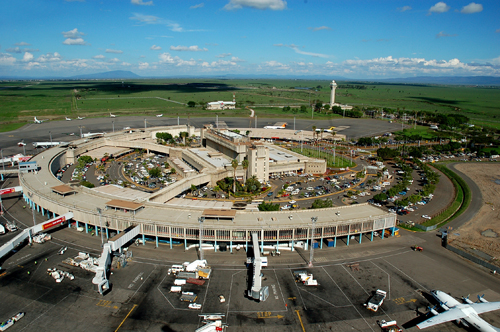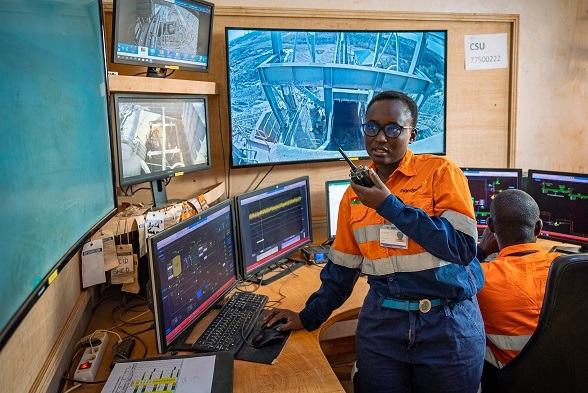
As with any country’s main airport JKI is the gateway to the country, and the people who fly in and out from all over the world, fairly or not, will judge Kenya by their first impression, gained as they struggle through the baggage reclaim and immigration checks. The first Kenyans they meet will be the airport staff. What greater PR opportunity could there be for a country and its people?
The responsibility for investing in the airports lies with KAA, the autonomous government body founded in 1991 to succeed the Aerodromes Department, then part of the Ministry of Transport and Communications. But responsibility for the day-to-day implementation of policy on the ground devolves upon the airport managers, especially the General Manager of JKI.
Edward Kobuthi was appointed to this post in December 2011, having previously been General Manager at Kenya Airways, one of the most successful airlines in Africa. Moving across from the role of the airport’s principal client to that of service provider gave him a unique insight into the business, he says. “I could hardly fail to understand the questions I had been asking as a customer!” But in addition to that he had an unusual background for an administrator, having been trained in process engineering. His experience in manufacturing with its emphasis on continuous improvement, efficiency and lean working was just what the airport needed, though it did present him with some initial challenges. Notable among these was trying to instil a mindset of effective working among staff used to the laid back attitudes prevalent in the civil services.
While much remains to be done, things have improved right across the board in the 15 months since his appointment. One of the first things he did was to call together his management team and set targets in all departments, his aim to meet the high expectations of the airport users. “This is no longer a local airport so they expect a level of service and an experience comparable to what they would receive at Heathrow or Schiphol. Of course delivering that in our constrained facilities is not easy to do, but that is what our improvements all aim to do.”
The existing terminal complex is an iconic circular structure with the three sections grouped around a central space recalling a traditional boma. Having been built in 1978, it is feeling its age and needs frequent repair. What it really needed was a thorough overhaul, but a renovation programme that was supposed to start in 2007 was put on hold, becoming part of the project to build a brand new fourth terminal. Meanwhile maintenance has been a matter of patch and make do, Kobuthi laments – understandably he is impatient to see the expansion project completed.
The new Terminal 4 currently under construction will complete the circle. It is a fully self-contained facility with a 23,000 square metre footprint, handling international arrivals and departures and separating them from domestic transit. It will handle 1,500 passengers an hour, with the check-in and bus terminal on the ground floor, seven departure gates on the first floor and arrivals above that.
The three storey parking garage for 1,500 vehicles that forms part of Terminal 4 is already nearing completion. To give an idea of its scale, the entire off-street parking provision for Nairobi only amounts to 6,000 places – its presence more than makes up for the open air parking that had to be sacrificed to the new terminal. Although it has been claimed that Terminal 4 will up the annual passenger throughput of the airport to nine million from the original three terminal’s design capacity of 2.5 million, it is actually designed to cope with an extra 2.5 million. When it is considered that around six million passengers currently pass through the airport, and it is indeed expected that nine million will be using it by next year, the scale of JKI’s under-capacity becomes clear.
Nevertheless Edward Kobuthi has not been content to wait. As soon as he came in he set in process a programme of across the board improvement that owed much to industrial lean practices. Despite the constrictions of the facility the results have been impressive and are reflected in the ratings achieved in JKI’s quarterly Airports Council International (ACI) audits. “Every single parameter showed improvement over the last year,” he says.
Putting in free Wi-fi access in the waiting areas gained a huge 16 percentage points improvement, while air-conditioning the departure lounge won a similar hike in ratings. Other areas scored markedly higher, including ground transportation, availability of parking, courtesy of staff and reduced waiting times at security; trolley availability and signage that makes it easier for passengers to find their way about.
No ACI category failed to show an improvement. And this comes after some much larger issues had been tackled. Failure in the baggage conveyor system had been frequently so they were thoroughly rehabilitated. More seriously, just before Kobuthi took up the reins the entire airport had been blacked out in a power cut. “I made it a priority to see that didn’t happen again and to see the power supply, especially to the airfield lighting, was robust. We now have generators powering two separate loops to the airside circuits – if one has a problem the other cuts in.”
Terminal 4 is behind its original schedule but should be fully commissioned by the end of the year, ready for the President to open it. Meanwhile work will commence on a brand new terminal building, quite separate from the original complex. The new ‘Greenfield’ terminal will solve JKI’s capacity issues for a long time to come, equipping it to meet a projected demand of 15 million passengers a year after 2016.
The design capacity of the new $650 million terminal is actually 20 million passengers a year. Designed by architects Pascal & Watson and supervised by consultants Louis Berger Group, a contract has been concluded with Anhui Construction Company of China and work is due to start in May of this year. The project will involve the construction of a new terminal building with a total floor area of 178,000 square metres on four levels, 45 associated aircraft stands, linking taxiways, with access roads and new vehicle parking areas.
Strategically situated at the interface between east and west, north and south, JKI is ideally placed to become Africa’s main international hub for passenger services. It has already gained that position in terms of cargo, having overtaken both Cairo and Johannesburg in terms of tonnage. It now handles over 300 million kilogrammes of cargo a year and is growing at an annual rate of ten percent. In a separate contract, work will start this year on a second runway at the airport. It should take a little under two years to build. The new 5.5 kilometre runway will be able to take the airbus A380 and thus open up the airport to direct long haul flights to destinations such as New York, carrying up to 32 tonnes. Edward Kobuthi can’t wait: “Once all these projects are complete Nairobi will finally take its rightful place alongside the top rank passenger and freight airports in the world.”
Written by John O'Hanlon, research by Robert Hodgson
DOWNLOAD
 KAA-Africa-T&L-June13-Bro-s.pdf
KAA-Africa-T&L-June13-Bro-s.pdf













